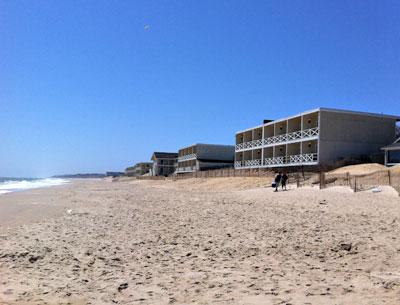More at Stake In Montauk Than Corps Says

Consultants for East Hampton Town have set the economic value of a beach reconstruction project in downtown Montauk, where storms have severely eroded the shore, at more than $238 million, if the prevention of damages to buildings and infrastructure and the ongoing costs of beach protection efforts and post-storm repairs are factored in.
The analysis prepared by First Coastal Corporation of Westhampton Beach differs considerably from one commissioned by the Army Corps of Engineers, which has committed to completing an emergency Montauk beach reconstruction effort at full federal expense, but only one that satisfies the agency’s cost-benefit formula.
Consultants for the Army Corps pegged the total economic benefit to be derived from a Montauk beach reconstruction project at $103.8 million.
In April, the federal agency offered to complete a $6 million reinforcement of 3,100 feet of the Montauk beach, installing sand-filled geotextile bags to reinforce the dunes and then covering them with 45,000 cubic yards of sand.
The proposal fell short for town officials, who had hoped to see a full-scale beach replenishment with construction of a “feeder beach” that would provide sand to replace what is continually lost through normal littoral drift.
An immediate project of a larger scope, the Army Corps said, is not considered economically justified under its emergency work authorization. However, Corps officials told the town, more extensive work could take place as part of its Fire Island to Montauk reformulation study, a longer-range scope of work that is being developed and is several years from implementation.
The study by First Coastal was commissioned to help the town convince the Army Corps that more extensive, immediate work is warranted.
East Hampton Town Supervisor Larry Cantwell said in a press release on Monday that the finding by First Coastal “lends support for Montauk to receive significantly more relief than what the Army Corps has already committed to the hamlet.”
“Without the construction of a feeder beach, the emergency project as currently proposed places Montauk in a vulnerable position,” said Mr. Cantwell in the release.
“Since the economic analysis is key tothe Army Corps’s justification for this project,” Mr. Cantwell said he is “urging the Army Corps to build a much more substantial project in Montauk as soon as possible.”
First Coastal calculated that a full beach reconstruction project would provide protection that could prevent more than $236 million in damages to buildings and both public and private infrastructure. That would include more than $205 million in damages to buildings, over $29 million in damages to private infrastructure services, such as water, electric, cable, telephone, and septic and drainage systems, and an estimated $694,650 in damages to public utility infrastructure, though that figure may be revised based on additional forthcoming information.
The total does not include the potential loss of income or loss of land. Those factors are still being calculated, First Coastal said in a memo to the town.
The tally includes an estimated $2.8 million in “costs avoided,” an estimate of what has been spent on dune restorations and maintenance, such as beach grass planting and sand fencing, and building repairs due to storm damage, in the Montauk downtown area between 2010 and 2013.
By contrast, a memo to town officials from First Coastal says, the economic analysis prepared by the Army Corps’s consultant, URS, does not factor in the $2.8 million in costs that would be avoided, nor does it include an inventory of the public and private infrastructures or of accessory buildings that could be damaged without storm protection.
The two analyses also differed in the numbers used for finished square footage in 43 downtown Montauk structures; First Coastal identified 411,154 square feet of space, while the Army Corps report used a 338,300-square-foot figure.
Estimates of construction costs for replacement of damaged structures also differed. In its memo to the town, First Coastal said that per-foot construction costs in Montauk are “substantially more” than the costs estimated by the Corps’s consultants.
Based on information from local contractors and consumers, First Coastal estimated the replacement costs at $425 to $475 per square foot, including furnishings. The Corps’s analysis pegs them at between $240 and $267 per square foot.
The federal agency’s consultants, the memo says, used cost-estimating software to estimate 2005 construction costs in Riverhead, then increased them by a factor to update them for 2013. The method, says First Coastal, does not recognize the geographic location and labor issues that make construction costs significantly higher in Montauk than in Riverhead.
The construction costs estimated by First Coastal reflects the cost to replace a structure in compliance with state and local building codes, as well as Federal Emergency Management Agency regulations, while the Army Corps’s report only accounts for the cost of replacing them as they were originally built, according to the First Coastal memo. “This does not take into account the fact that the majority of these buildings are currently not” up to the codes, the memo says.
“The Army Corps is reacting, in a dialogue with First Coastal, in regard to that data,” Supervisor Cantwell said of the consultants’ analysis, at a town board meeting on Tuesday. “So I’m hopeful.”
